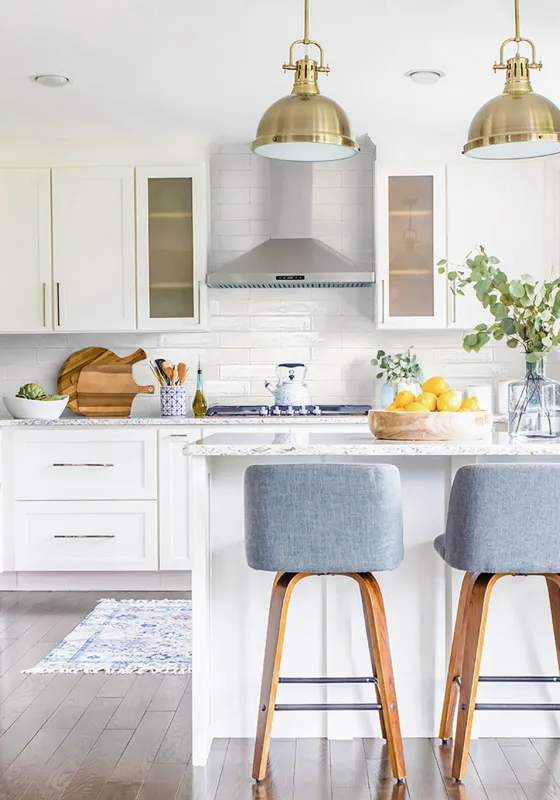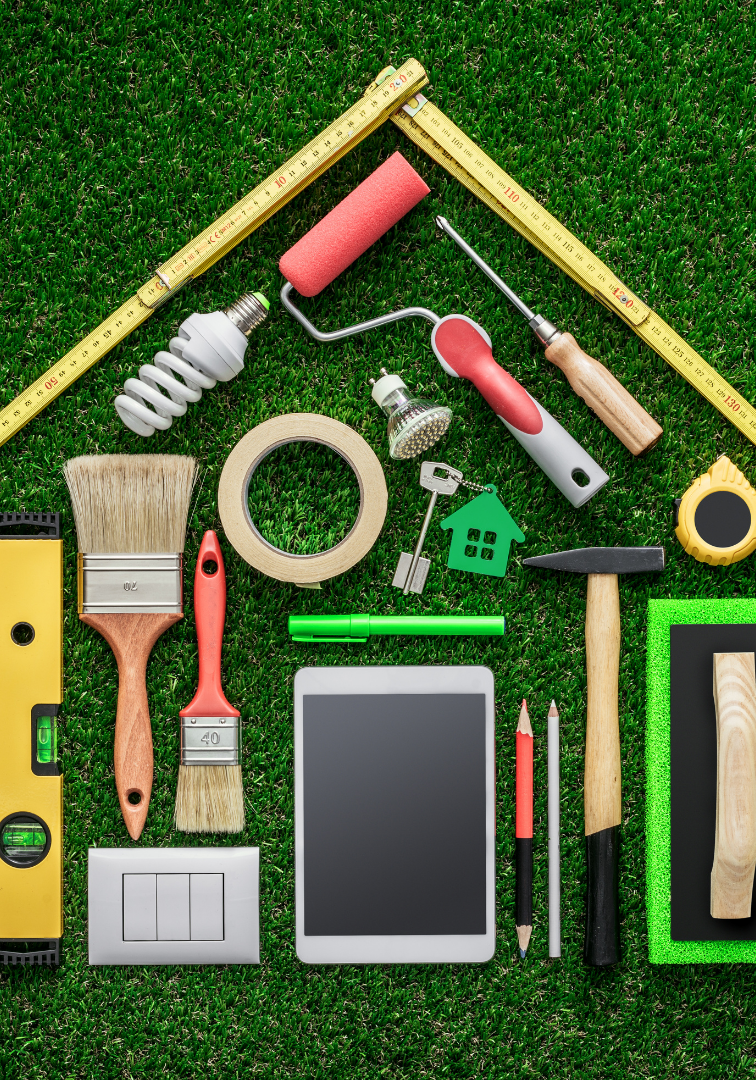
Moving into Your New Home Checklist
Moving into a new home is an exciting time, and you’re probably daydreaming about decor and paint schemes and new furniture. But before you get into the fun stuff, there are some basics you should cover first.
Change the Locks: Even if you’re promised that new locks have been installed in your home, you can never be too careful. It’s worth the money to have the peace of mind that comes with knowing that no one else has the keys to your home. Changing the locks can be a DIY project, or you can call in a locksmith for a little extra money.
Steam Clean the Carpets: It’s good to get a fresh start with your floors before you start decorating. The previous owners may have had pets, young children, or just some plain old clumsiness. Take the time to steam clean the carpets so that your floors are free of stains and allergens. It’s pretty easy and affordable to rent a steam cleaner—your local grocery store may have them available.
Call an Exterminator: Prior to move-in, you probably haven’t spent enough time in the house to get a view of any pests that may be lurking. Call an exterminator to take care of any mice, insects, and other critters that may be hiding in your home.
Clean out the Kitchen: If the previous occupants wanted to skip on some of their cleaning duties when they moved out, the kitchen is where they probably cut corners. Wipe down the inside of cabinets, clean out the refrigerator, clean the oven, and clean in the nooks and crannies underneath the appliances.
Dispelling Refinancing Myths
“Refinancing” is a scary word for many people, but that shouldn’t be the case for you. For many homeowners, refinancing can not only lower your monthly payments and help with your monthly budget, but it can save you thousands of dollars in the long run.
YOU’RE NOT TOO LATE.
For years now, we’ve been hearing that interest rates will be on the rise, and although there have been some small increases, you’re still in a great position to drastically lower your interest rate. The general rule is if your mortgage interest rate is more than one percent above the current market rate, you should consider refinancing.
IT’S NOT TOO TIME-CONSUMING.
Don’t brush off refinancing just because it seems like a long and daunting process. An informational call with a lender to see how rates compare will only take a few minutes. There are also some programs for streamlining the application process. And besides, isn’t the amount of money you could save worth the time and effort?
ARMS CAN BE REFINANCED, TOO.
Seeing your Adjustable Rate Mortgage (ARM) increase after the introductory period can be incredibly stressful and place a squeeze on your budget. Many people assume they’re stuck, but ARMs can be refinanced, just like fixed-rate mortgages. You can even switch to a shorter term fixed-rate mortgage, such as 15 or 23 years. The longer you’re planning to stay in the home, the more sense it makes to look into refinancing.


Finding the Right Mattress
You’ve got more options than ever when mattress shopping these days with no shortage of brick-and-mortar and online-only retailers to choose from. Here are the factors you should consider when you’re shopping for a perfect night’s sleep.
- Mattress Construction: The most popular mattress types are inner spring mattresses, memory foam mattresses, and adjustable air mattresses. Each has pros and cons when it comes to durability and comfort customization.
- Firmness: Mattress firmness plays a huge role in the quality of your sleep. Mattresses that are too firm or too soft can cause aches and pains, so it‘s recommended that you test a mattress for 10- to 15 minutes in store before making a purchase.
- Sleeping position: Your mattress should match your sleeping style (side, back, face-down, etc.). You want a mattress that keeps your spine in proper alignment. For example, some mattresses are better for side sleepers, while others are better for back sleepers.
- Size: It’s not quite as simple as choosing between a king and a queen mattress. You should also consider your height, as some mattresses are a better fit for shorter people while tall people will want a longer mattress so their limbs aren’t hanging over the edge of the bed.
- Stability: For couples, you should consider how the mattress reacts when one person moves, so the other person’s sleep isn’t disturbed in the middle of the night.
Must-Have Tools for Homeowners
When you own your home, things are going to break and, unless you want to spend your money on visits from a neighborhood handyman, you’re going to need to fix them yourself. Luckily, you don’t need an arsenal of tools to handle most home maintenance fixes. These five tools will cover most of your basic projects.
- Cordless Drill. A cordless drill is a must-have for installing cabinets, drawer pulls, hinges, picture frames, shelves and hooks, and more. Whether it’s for do-it-yourself projects or repairs, you’ll use your cordless drill just about every month.
- Drain Cleaners. Shower and bathroom sink drains are susceptible to clogs because of the daily buildup of hair and whisker clippings. You can use chemical clog removers like Drano, but they’re expensive and the lingering chemical scent is unpleasant. Instead, buy some plastic drain cleaners that can reach into the drain to pull out the clog of hair and gunk. You can purchase them on Amazon or at a local hardware store for a low price.
- Shop-vac. No matter how careful you are, spills and accidents will happen and there are some tasks that just can’t be handled with paper towels or a standard vacuum, like pet messes or broken glass.
- Loppers. Even the minimum amount of care for your landscaping will require some loppers to remove damaged branches, vines, thick weeds, and any other unruly plants in your yard.
- Flashlight. You’re going to want something a little more powerful than your iPhone flashlight when you’re in the crawlspace!


Create the Home Office of Your Dreams
Whether you work full-time at home or occasionally need to conduct business in the evenings or on the weekends, a home office a great way to utilize an extra room. A dedicated workspace in your home can be designed to increase productivity and comfort. Here are 5 ideas to get you started.
- Invest in a good office chair. Investing in an ergonomic office chair is essential. You may be spending anywhere from 30 to 50 hours a week sitting in it, so your back will thank you. Purchasing one with multiple adjustments is ideal so it fits you just right.
- Switch up your lighting. Fluorescent lighting has been proven to be hard on the eyes. Make the switch to LED or halogen light bulbs in your home office and try to let in as much natural light as possible. Also, consider finding a desk lamp to reduce headaches and eye strain.
- Keep essentials in reach and organized. Nothing says productivity like a clean, neat workspace. Select a desk with a lot of storage or install creative shelving to keep items like pens, pencils, extra batteries, calculators, notepads, and more stored within arm’s reach.
- Decorate bright. Pick a color you love and use it to spice up the room. Use cheery yellow or red or relaxing tones like green and blue, instead of beiges and browns.
- Aim for the view. If possible, place your desk so you are facing a window instead of a blank wall. Natural light can do wonders for staying alert and you can give yourself a short mental break when necessary by looking to the outdoors.
Easy Landscaping DIY Projects
Ever get the itch to do a DIY project? Whenever we do, our favorites involve getting outdoors and mixing up our landscaping features.
Whether it's as simple as installing some lighting or a little more time-consuming like re-plotting plants, a fresh look for the lawn always gives your home a fresh look as well. Here are our top five easy landscaping projects!
Create a Pathway.
To guide you and visitors throughout your yard and link different areas together, install a pathway. You can use materials from a variety of materials, including reclaimed pallet wood, flagstones, gravel, and more to add texture and color.
Add a Wall or Border.
Installing a flagstone, rock, or brick wall around flower beds or trees adds a sleek, clean look to your landscaping and helps separate different sections of your yard.
Install a Water Feature.
Nothing says zen quite like the sound of trickling water as you relax in your backyard. You can start simple with by purchasing and installing a small feature powered by a solar panel or create a larger focal point in your yard by installing a waterfall wall or small pond.
Light Your Way.
An easy way to transform your yard is to strategically use lighting. Place cool-colored lights high in trees to recreate a moonlight feel, use pathway lights to naturally guide the eye, or highlight objects or plants.
Plant Upwards.
Expand your yard space by drawing the eye to the sky with a trellis fence or screen made of wood or metal. Once you install your trellis, select your climbing plants and vines and get to planting!


Create an Evacuation Plan For Your Pets
An evacuation plan is a necessity for every home, especially if you live in an area where fires, earthquakes, hurricanes, flooding, and other disasters are a possibility. Many homeowners create evacuation plans for their homes and practice them with their kids, but far fewer have considered one for their pets. Take these steps to add your pets to your evacuation plan.
Assign pet evacuation to an adult. Everyone should know how to act during an evacuation, and that includes assigning one parent or adult to the pets. This allows the other parent and the children to focus on their part of the evacuation plan, so there’s no confusion during a high-stress moment when time is of the essence.
Keep evacuation maps and pet carriers readily accessible. If you need to evacuate, you should know exactly where every important item is. If you pets require carriers, keep them in a place that you can access easily.
Practice your plan. Include your pets in your home evacuation drills. It’ll help you see how they will respond and make changes to your plan if necessary. Getting your dog out of a window may not be as simple as you think!
Be prepared in case you get separated from your pets. No matter how much you drill your evacuation plan, it’s possible that a dog or cat will run off while you’re focusing on keeping your family safe. A microchip or a GPS-compatible tag can help you find your pets once it’s safe to return to the area.
